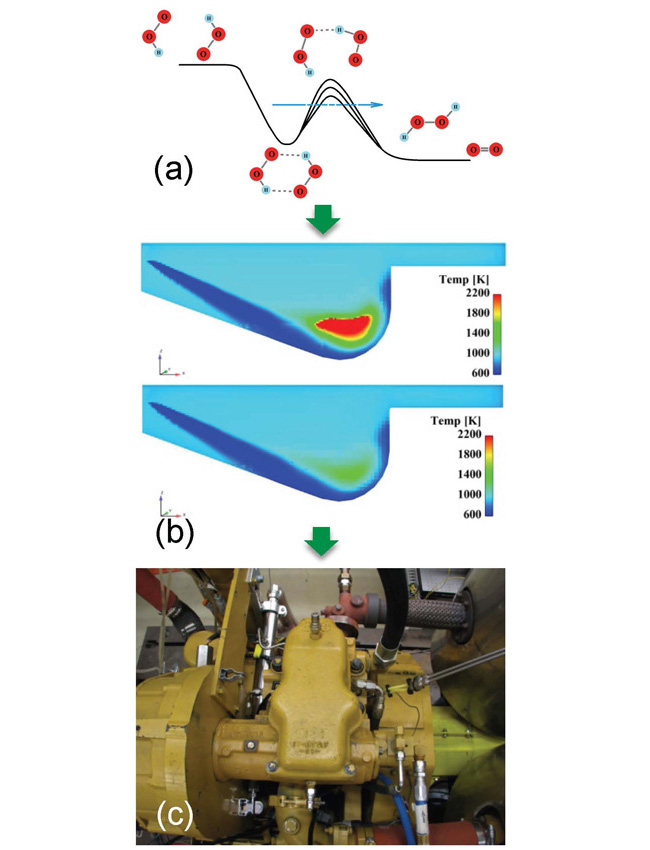Quantum Tunneling Affects Engine Performance
Understanding fundamental chemistry is important for accurate engine modeling.

The Science
The role of individual molecular reaction rates in complex combustion processes in engines has been assessed in computer simulations of the combustion of a model biodiesel fuel This study is part of a larger investigation of how quantum chemistry – that is, the forces acting between electrons, atoms, and molecules that determine rates and energy in individual chemical reactions – affects the predictions of high fidelity combustion simulations, wherein thousands of reactions and fluid mechanics interact in actual engines.
The Impact
The performance of advanced compression-ignition engines is increasingly tied to the details of the fuel combustion chemistry, and models used in the design and optimization of such engines require a detailed and accurate description of this chemistry. The study shows that one can now move seamlessly from quantum chemistry to engine modeling, and use the results of engine simulations for motivating new fundamental studies to address deficiencies in our knowledge of the chemistry that occurs at engine-relevant conditions.
Summary
Researchers have recently studied the role of individual reaction rates on engine performance, with an emphasis on the role of quantum tunneling, an exclusively quantum mechanical phenomenon whereby a product can emerge even if reactants have insufficient energy to overcome forces impeding the reaction. Actual combustion processes occurring in engines are profoundly complex, with engine performance emerging from myriad chemical reactions interacting in the engine environment. Accurate computational models including this complexity have been prohibitively difficult to implement. For this reason, practical combustion simulators seldom include all of the underlying chemical detail and may miss important molecular-level quantum mechanical effects. This research demonstrated that quantum tunneling corrections for the rate of the reaction HO2 + HO2 = H2O2 + O2 can have a noticeable impact on the performance of a high-fidelity model of a diesel engine. The three-dimensional model included detailed descriptions of the chemistry of a surrogate for a biodiesel fuel, as well as all the features of the engine, such as the liquid fuel spray and turbulence. This study was part of a larger investigation of how the molecular –level features of key chemical reactions, their dynamics and potential energy surfaces, as well as their reaction rate uncertainties, affected engine performance.
Contact
Stephen T. Pratt
stpratt@anl.gov
Funding
Department of Energy, Office of Science, Basic Energy Sciences and Office of Energy Efficiency and Renewable Energy, Office of Vehicle Technologies.
Publications
S. Som, W. Liu, D. D. Y. Zhou, G. M. Magnotti, R. Sivaramakrishnan, D. E. Longman, R. T. Skodje, and M. J. Davis, “Quantum tunneling affects engine performance”, J. Phys. Chem. Lett. 4, 2021 (2013) [DOI: 10.1021/jz400874s].
W. Liu, R. Sivaramakrishnan, M. J. Davis, S. Som, D. E. Longman, and T. F. Lu, “Development of a reduced biodiesel surrogate model for compression ignition engine modeling”, Proc. Combust. Inst. 34, 401 (2013). [DOI: 10.1016/j.proci.2012.05.090].
D. D. Y. Zhou, K. Han, P. Zhang, L. B. Harding, M. J. Davis, and R. T. Skodje, “Theoretical determination of the rate coefficient for the HO2 + HO2 ® H2O2 + O2 reaction: Adiabatic treatment of anharmonic torsional effects”, J. Phys. Chem. A 116, 2089 (2012) [DOI: 10.1021/jp209684s].
Highlight Categories
Performer: DOE Laboratory
Additional: Technology Impact , Collaborations , EERE



